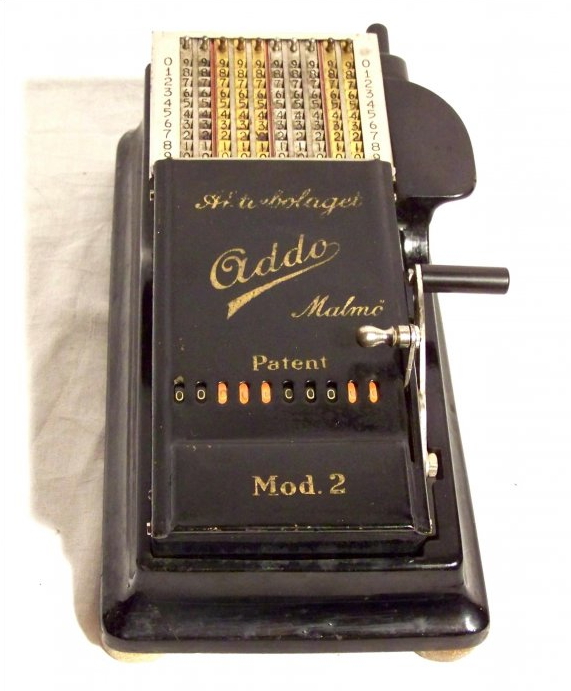
This by now rare surviving example of the Addo adder was produced by the AB Addo (Aktiebolaget Addo) Swedish engineering company in Malmö, founded by Hugo Agrell in 1918,1 which focussed on the manufacture of office machines. The company was founded in 1918 and in 1966 was incorporated into the Facit company as a subsidiary where it continued until the early 1980s. It produced a range of calculators and data processing equipment.2
The machine is a miniature adding machine adding by means of a rack mechanism, with 10 racks allowing a number to be input to 10 decimal places. It came in three versions, with model 2 and 3 non-printing (3 being for English currency) and model 4 having a printing mechanism. Racks are moved with a stylus, the original being retained in this fine surviving example of the machine. A lower set of windows allow the input result to be checked and the final result to be read off.
The outer crank lever on the right is used to perform the accumulation by transferring the number set on the rack to the accumulation register in the windows of the lower panel. The inner crank is available to set the accumulation register back to zero. Complementary numbers are inscribed from 0 to 9 down the left and right edges of the rack mechanism to assist subtraction being performed using complementary arithmetic.3
1 Anthea Agrell in http://www.vintagecalculators.com/html/addo.html viewed 4 Mar 2014 (↑)
2 http://en.wikipedia.org/w/index.php?title=AB_Addo&oldid=575699742 viewed 4 Mar 2014 (↑)
3 See also Ernst Martin, “Die Rechenmaschinen”, 1925, and translated into English as Ernst Martin, “The Calculating Machines”, MIT Press and The Charles Babbage Institute, USA, “History of Computing” series, 1992, p. 301–2 (↑)
Pages linked to this page
 This work by Jim Falk is licensed under a Creative Commons Attribution-NonCommercial-NoDerivs 3.0 Unported License Click on the logo to the left to see the terms on which you can use it.
This work by Jim Falk is licensed under a Creative Commons Attribution-NonCommercial-NoDerivs 3.0 Unported License Click on the logo to the left to see the terms on which you can use it.